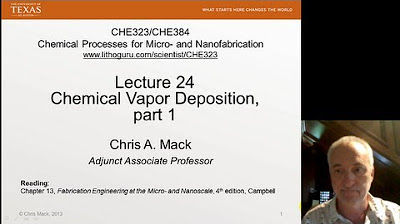Lecture 23 (CHE 323) Sputtering, part 2
Summary
TLDRThis lecture, part of a series on sputtering, focuses on step coverage during sputter deposition in micro and nanofabrication. Professor Chris Mack explains how step coverage can be optimized by controlling factors like mean free path and deposition angle, while discussing the challenges of void formation in via filling. He covers methods to improve step coverage, including collimation and ionization, as well as sputter cleaning to remove surface contaminants. The lecture also touches on stress in metal films, its impact on reliability, and how film quality is measured in terms of composition, reflectivity, and electrical properties.
Takeaways
- 🔬 Sputtering achieves good but not perfect step coverage by having a small mean free path, enabling material to deposit at various angles, reducing shadowing effects.
- 🌡 Step coverage can be improved by increasing the mobility of deposited material via diffusion, typically through heating, though excessive heat can cause metal grain formation and roughness.
- 📏 Specular reflectivity is a key measure for monitoring surface roughness during deposition. Decreased reflectivity indicates increased roughness.
- ⚡️ Via fill applications may require poor step coverage to avoid voids during metal deposition in small contact holes, improving reliability.
- 🛠 Collimators or ionized sputtering are used to reduce step coverage by directing sputtered atoms vertically, enhancing control over the deposition process.
- 🧼 Sputter cleaning involves applying a negative bias to the wafer to remove surface contaminants before deposition, but it risks damaging delicate substrates.
- ⚡️ Bias sputtering allows simultaneous deposition and etching, improving step coverage and thickness uniformity, particularly for holes or trenches in the wafer.
- ⚙️ Aluminum alloy with small amounts of silicon and copper is commonly used in metallization, and sputtering can easily maintain the desired alloy composition.
- 📐 Stress in deposited films, often due to thermal expansion mismatches, can affect reliability. Measuring wafer bow before and after deposition helps monitor stress levels.
- 🎯 Film quality is determined by composition, electrical and mechanical properties, adhesion, thickness, uniformity, step coverage, reflectivity, and refractive index.
Q & A
What is step coverage in the context of sputter deposition?
-Step coverage refers to how well a sputtered material covers the features on a wafer surface, particularly around steps or edges. Good step coverage involves depositing material uniformly across these features, although perfect coverage is difficult to achieve due to factors like shadowing.
How does sputter deposition achieve relatively good step coverage?
-Sputter deposition achieves good step coverage by creating a range of angles at which the target atoms strike the wafer. A small mean free path for the sputtered particles, which causes more scattering, also helps improve coverage.
What is the role of the sticking coefficient in sputtering?
-The sticking coefficient determines how likely atoms are to remain where they first land on the wafer. Materials with higher sticking coefficients will stay where they first hit, while lower coefficients may allow atoms to bounce off and land elsewhere.
What is the trade-off between heating the wafer to improve step coverage and potential material issues?
-Heating the wafer can increase the mobility of the deposited material, leading to better step coverage. However, if the temperature is too high, metal grains may form, causing roughness, potential reliability issues, and reduced conductivity.
How is roughness in deposited films monitored during sputtering?
-Roughness is monitored using specular reflectivity. If specular reflectivity decreases, it indicates an increase in scattering due to surface roughness. This is an easy way to track whether metal grains are getting too large.
Why might worse step coverage be desirable in some applications, such as via filling?
-In via filling, worse step coverage can help prevent void formation. By depositing the material unevenly, thicker layers form at the top and bottom of the hole, reducing the risk of voids forming in the center, which can cause reliability issues.
How can step coverage be reduced intentionally in sputtering processes?
-Step coverage can be reduced by directing the sputtered atoms more vertically toward the wafer. This can be achieved by lowering the pressure to increase the mean free path, or by using a collimator or electric fields to guide atoms vertically.
What is sputter cleaning, and why is it used?
-Sputter cleaning involves applying a negative bias to the wafer, causing argon ions to sputter-etch the wafer surface. It helps remove contaminants, like native oxide layers, before new materials are deposited, ensuring better contact and cleanliness.
What are the potential risks of sputter cleaning?
-Sputter cleaning can damage delicate parts of the wafer if not controlled properly. The etching effect from the argon ions may be too aggressive for certain substrates, potentially leading to damage before deposition.
How is film stress in deposited metals measured, and why is it important?
-Film stress is measured by observing changes in wafer bow before and after deposition. Stress can lead to grain boundary movement, which accelerates failure when current runs through the metal. Low-stress films are essential for long-term reliability.
Outlines

This section is available to paid users only. Please upgrade to access this part.
Upgrade NowMindmap

This section is available to paid users only. Please upgrade to access this part.
Upgrade NowKeywords

This section is available to paid users only. Please upgrade to access this part.
Upgrade NowHighlights

This section is available to paid users only. Please upgrade to access this part.
Upgrade NowTranscripts

This section is available to paid users only. Please upgrade to access this part.
Upgrade NowBrowse More Related Video

Lecture 22 (CHE 323) Sputtering, part 1

Lecture 25 (CHE 323) CVD, part 2

Lecture 24 (CHE 323) CVD, part 1

8253/54 Programmable Interval Timer: Block Diagram, Features, and Control Word Explained

Chemical Vapor Deposition: Basic Function - Nanotechnology: A Maker’s Course

Grain Shape in Detrital Sedimentary Rocks: Angularity, & Surface Textures / Sed Strat #3 | GEO GIRL
5.0 / 5 (0 votes)